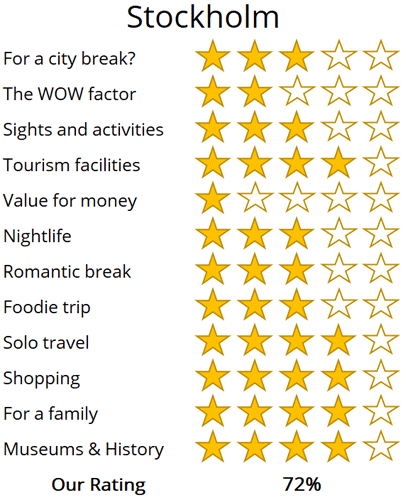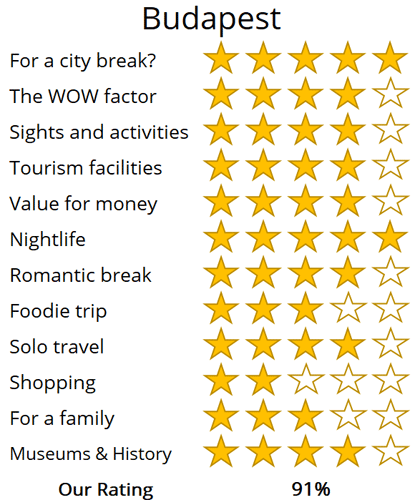WhereToGoForMyHoliday.com
The best destination comparison site!
WhereToGoForMyHoliday.com
The best destination comparison site!
Stockholm or Budapest, which is better for your holiday in 2024?
Stockholm and Budapest both offer unique and enticing experiences, but which one should you choose for your city break or holiday?
We understand your dilemma. There is an abundance of travel guides for both cities, but few actually comparing them, and advising you which is the better for your trip.
This article will provide our unbiased and independent views of Budapest and Stockholm, hopefully making your choice that little easier.
The article is structured into several sections, each of which can be directly accessed through the following links:
• Introduction to the cities
• Scores and ratings
• Which one should I, friends, or family visit?
• When to visit and weather
• Who is the city suited for?
• The perfect 48hours (with map)
• Tourism details (where to stay? airport details?)
Introduction to Stockholm and Budapest
Magical, mystical Stockholm spreads over a speckling of islets surrounded by the icy Baltic Sea. At its centre is the fairy-tale Gamla Stan. Cobbled lanes wiggle and writhe around medieval rowhouses in those parts, opening onto a kitschy plaza filled with gingerbread cafés and grand Neo-Classical palaces.
Next door is happening Södermalm, a lived-in quarter with hipster meatball dives and ethnic eateries. Then there are Norrmalm and Östermalm, where amazing museums meet shopping strips and food halls.
Reputation has it that Stockholm isn't cheap. And it's true, this Scandi capital will set you back a bunch. But try not to let that put you off. There are rewards for loosening the purse strings, from days of fika (cosy coffee breaks) to encounters with ABBA the band to experiencing the buzz of a city that's at once modern and historic.
Straddling the snaking Danube in the very heart of Europe is Budapest, the buzzing capital of Hungary.
Here, a city of two halves – Buda and Pest – unites to form a complex tapestry of over 1.7 million lives. With grand 19th-century bridges stitching together the landscape, Budapest entices with its blend of storied history, striking architecture, café charm, and lively nightspots.
Whether your eyes are drawn to the regal palaces atop Buda Hill or the heady aroma of sulphur from steaming bathhouses, Budapest never ceases to captivate. Venture into ruin bars, gaze upon the monumental Dohány Street Synagogue, or stroll the wide boulevards left behind by the Communist era.
In Budapest, every glance reveals a new layer of intrigue, a city where the past and present are locked in an endless dance.
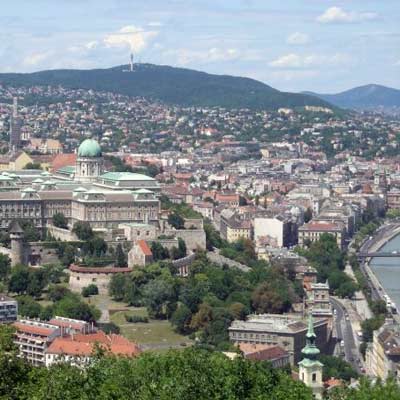
Budapest is a vibrant and modern city just waiting to be explored

Stockholm lies on an Archipelago of islands between Lake Mälaren and the Baltic Sea
Stockholm vs Budapest: City Ratings
Summary
Where would I journey for a personal escape?
Budapest
Where would I send my parents for a memorable visit?
Budapest
Where's the ideal destination for my adventurous 19-year-old cousin?
Budapest
Where should my food-obsessed friend indulge their culinary passions?
Budapest
Note: The above comparisons are weather-independent and are based on travel during the most opportune times of the year. Details about the ideal travel seasons are elaborated upon later in this article.
In the sections that follow, you'll find a comprehensive comparison between these two fascinating cities. This includes recommendations on the duration of stay, the best times to visit, and tailored 48-hour itineraries for each city.
The final segment delves into practicalities for your travels, such as the best airport to fly into, the optimal districts for your accommodation, and insider tips, for when you come to explore the city.
We hope that you find all of this information useful, in planning your next exciting trip!
Destination details
How long to spend each city?
Fly-in visits for three days are enough to check off the major must-see sights of Budapest. This is a compact capital with good underground and bus links. You can get easily get across town – going from Buda Castle on one side of the city all the way to the Széchenyi Thermal Baths at the other takes less than an hour on public transport.
That said, Budapest has plenty of hidden secrets up its sleeve. You could easily while away a whole week enjoying cheap happy hours in the ruin bars, bathing in the Art Deco spas, and visiting islands up the Danube. If you're coming in summer, you could also extend a stay to include the art galleries and cobbled lanes of Szentendre, the mineral-rich waters of Lake Balaton, and the rustic Tokaj wine country to the east.
Stockholm is a perfect city break spot. Two or three days is a great amount of time to while away between the historic Gamla Stan and the museums of Östermalm. What's more, planning a fly-in, fly-out jaunt has never been easier. There are no fewer than four airports serving the town, from big Stockholm-Arlanda to low-cost favourite Skavsta Airport. The advantage? It should be a cinch to find affordable connections in and out, say 72 hours apart.
If you've got a little more time to spare, then use it. Stockholm has secrets that aren't on the main tourist menu. For example, you could venture out to the rugged islands of the outer Stockholm Archipelago. They're for sailing, swimming, fishing, and wandering quaint villages. There are also the Viking relics of Birka and the idyllic forests and lake lands of Bornsjön. All those will require more than just a weekend.
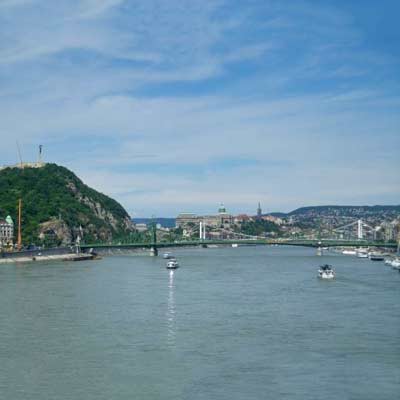
The mighty Danube River cuts Budapest in two

The waterfront of the Sodermalm district in Stockholm
Wrap up warm if you're heading north in the winter months. Stockholm is a cold capital, but it comes with hefty sides of festive charm. At Christmas, you'll find lovely markets on Stortorget square in the middle of the Gamla Stan, the scents of mulled wine and hot chocolate floating up through the pastel-painted guild mansions. On the flip side, November to March also means uber-short days (think sunset as early as 3pm!) and lots of rain and snowfall.
If you prefer a dose of Vitamin D, consider the white nights of summer. It doesn't get dark until well into the evening between June and August. What's more, the weather is usually warm and mild, with daily averages in the low 20s. Of course, this is also the most popular time to come, so expect hotel rates to be inflated.
Late spring and early autumn are when locals often say Budapest is at its best. Temperatures average around 23-25 degrees in May and September. There's not an overload of rain then either. And it's perfect for avoiding the crowds of midsummer city breakers that come during the European holidays.
There's also something to be said for visiting Budapest in the midst of winter. Mercury plummets between November and March, and it's not uncommon to see the Danube freeze over with huge chunks of ice. What's more, the tenements and side streets of the Jewish Quarter and the historic Inner City areas ooze atmosphere on cold, snowy days. Just be sure to pack the thermals!
Budapest, with its rich historical culture, intertwined seamlessly with an energetic nightlife, has established it as a top destination for a diverse range of travellers. Backpackers gravitate towards the Jewish Quarter's unique ruin bars, where they can indulge in exceptionally affordable Hungarian beers amidst eclectic courtyards.
Meanwhile, those with a cultural focus may choose to delve into the history of the Hungarian empire at Buda Castle or pay homage at the poignant House of Terror museum, which delves into the oppressive Stasi era.
However, if your preference leans towards sun-soaked beaches, Budapest might not feel like a perfect fit. Situated in a landlocked region, both the city and the country are devoid of coastline. Furthermore, while there are parks, they are predominantly located on the city's periphery, making Budapest predominantly an urban experience.
If you're a fan of culture-brimming capitals and enchanting old towns, then Stockholm is sure to impress. Whole days of wandering between waterside parks, centuries-old terraces, cobbled squares and stooped taverns are on the menu. And so are visits to places like the Vasa Museum, with its 17th-century Swedish warship pulled up from the deep.
In addition to all that, districts like Södermalm are there to entertain the foodie and the art lover. It's a vibrant mix of multicultural cafés and restaurants. On one corner you'll see a Bahian curry stall, on the next you'll catch a Lebanese rice kitchen. And that's not even mentioning the wealth of fair-trade coffee shops and roasteries that make an appearance.
It's also quite pricy, so we'd recommend anyone on a budget to steer well clear.

The Royal palace in Stockholm
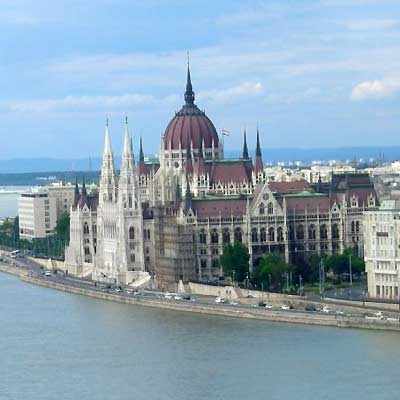
The Hungarian Parliament stands as a stunning testament to Budapest's architectural grandeur, holding the title of the city's tallest building
48hours in Budapest
Day 1: Begin your journey on the Pest side of the city, where the magnificent Dohány Street Synagogue resides. This landmark is not only pivotal to Budapest but also stands as the largest synagogue in Europe. Following this, take a stroll along Andrássy Avenue, a grand boulevard and UNESCO World Heritage site, adorned with Neo-Classical mansions.
Delve into Hungary’s tumultuous history with a visit to the House of Terror museum, situated at one end of the avenue. Subsequently, unwind with a spa session at the renowned Széchenyi Baths, celebrated for its Art Deco architecture. Cap off the day with a hearty dinner at Gettó Gulyás, indulging in their signature paprika-smoked goulash, and conclude your evening with a drink at Szimpla Kert, a mesmerizing art gallery turned bar.
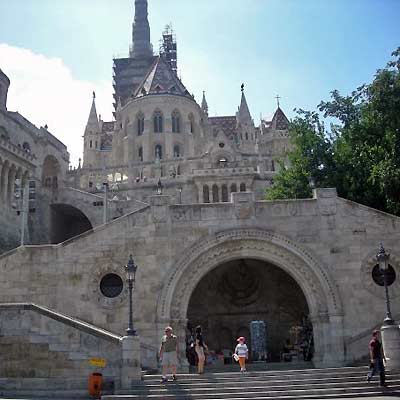
Pest cathedral
Day 2: Start your day with breakfast at the historic Central Market Hall, established in 1897. Savour the taste of sweet Hungarian pastries before crossing the Danube via the striking Liberty Bridge.
Upon arrival, you have the option to visit the elegant Gellért Baths or continue your journey to the Fisherman's Bastion and the Citadella, former military strongholds that now offer breathtaking views of the Danube. A northward stroll leads you to the Castle District, where you can either admire the architecture from the outside or explore the regal court rooms inside.
Don’t miss the chance to capture some photos of the imposing Hungarian Parliament Building across the river. Conclude your day with dinner in the Inner City of Pest, offering a diverse range of dining options from Tex-Mex restaurants to atmospheric 1930s speakeasies.

Gellért Hill offers some of the best views of Budapest, the hill is named after Saint Gerard who was murdered in 1065 by being put in a barrel and rolled down the hill…
48hours in Stockholm
Let's get stuck into Stockholm with this curated 48-hour itinerary. It whisks you from the aged heart of the town to some of its lived-in outer areas, and passes acclaimed museums and eateries as it goes…
Day 1: Hop out at Gamla Stan station in the early morning. Doing that puts you right at the meeting point of the Free Walking Tour Stockholm. Their trips typically take around two hours from start to finish, but they're a fine intro to all the secrets and monuments of the amazing district.
You'll probably encounter the bustling shopping thoroughfare of Stora Nygatan, the narrow alley of Prästgatan, and the handsome Stortorget square, all topped off with the stunning Royal Palace of Stockholm to learn about the boundary-breaking monarchy of Sweden. Once it's finished, be sure to stroll down cobbled Österlånggatan between the toyshops and Nordic taverns.
Have something to eat there and then move south across the water to Södermalm. One of the first things you'll encounter is the Katarina Elevator, with its high lookout points gazing across the old town. A few blocks to the south and you'll be in SoFo. This is the hipster hub of the city. If you can get a place, be sure to dine at quirky Meatballs for the People – expect modern twists on Scandi staples. If not, there are oodles of ramen places and Indian joints to boot.

Stockholm 5
Day 2: Breakfast at the Hötorgshallen. A colossal, two-floor food court, it's bursting with pretzels, smoked-salmon outlets, New Yorker delis, and more. It's also on the edge of Norrmalm's chic shopping area. Wander that to see designer outlets galore before emerging onto the salt-washed quays around Berzelii Park.
From there, you'll be able to see the forested island of Djurgården – your next destination. It's a short walk, with a few riverside cafes like the Sjöcafeet to enjoy en route. Then you delve straight into the Vasa Museum. Simply not to be missed, it's a chart-topper of Stockholm. The whole exhibit revolves around a mighty warship that sunk in Stockholm harbour just minutes after launching in the 17th century.
If time allows, ABBA the Museum is also next door, complete with glitzy pop paraphernalia and the piano on which some of the band's hit tracks were written. Behind all that is the vast open-air museum come park of Skansen. It's got living history that'll transport you back to medieval Sweden, along with a fun funicular train ride and even enclosures with brown bears.

The colourful house on the Stortorget, the main Square of Stockholm
Stockholm has four individual airports. Stockholm-Arlanda is the largest. That's where you're likely to land on long-haul connections. The direct Flygbussarna transfer can get you back and forth in just 45 minutes, but there's also express rail straight to the terminal.
Skavsta Airport is a hub for low-cost carriers like Ryanair and is linked to the city by private coach transfers (travel time: 1.2 hours). Bromma Airport is mainly for domestic links and also has buses straight to the city. Finally, there's Västerås Airport. Over 60 miles to the west, it's popular for Sweden-UK flights. A coach transfer there takes around 80 minutes in total.
If you're struggling on deciding where to stay in Stockholm, look no further than the northern quarters of Södermalm. That's a good balance between affordability, convenience, and proximity to the Gamla Stan. Of course, there are also hotels in the middle of the old town, but you'll usually need to fork out more for the immersion.
Related articles: Where to stay in Stockholm
By far the best way to navigate is on the Storstockholms Lokaltrafik network. The metro is very efficient and clean, running regularly from stop to stop. Get yourself a combined SL Travel Card that allows for unlimited travel for the duration of your trip. These cost around 240 SEK ($25) for three days but will certainly save you money in the long run.

The Royal crown of Sweden and the Royal Palace to the rear
Stockholm is one of the safest capital cities in Europe, though problems are not unheard of. There are still pickpockets and muggings but stay sensible and calm and they are very unlikely to affect your trip. The most common places to fall victim to these sorts of crimes are on the subway, in the Gamla Stan, and in busy food halls..
Never stand on the cycle lane in Stockholm. Getting around on two wheels is an important mode of commuting for many locals. They don't take kindly to folk who get in their way!
Travelling to and around Budapest is super easy. There's an efficient underground network. Tickets for that cost 350 HUF per ride with a single transfer allowed. You can also use river boats (HUF750 per journey) and buses (350 HUF).
Taxis are rarely needed, but they are cheap, costing 280 HUF per kilometer. Be sure to insist your driver puts the meter on, and never accept offers from taxi touts at the airport.

The Fisherman's Bastion, Budapest
Talking of the airport, Budapest Airport sits around 22 kilometers from the city center. You can get to and from the terminals using the dedicated express bus (€2) or by train (€2.70). Both options take between 30-40 minutes. Be sure to buy tickets at machines by the stops – they're more expensive when purchased direct from drivers.
When it comes to picking hotels in Budapest, you're best off focussing on the Pest side of the city. That's where the bulk of the best lodgings are located. Being in the Jewish Quarter can be noisy, but perfect if you want to hit the nightlife of Szimpla and the other ruin bars. The Inner City area is charming and quieter, with some boutique options. Meanwhile, Újlipótváros is a local's favourite, with its cool cafés and art galleries and sleek Airbnbs.
Related articles: Where to stay in Budapest
Budapest is largely safe and crime statistics are in line with European norms. Some well-known scams include taxi drivers who overcharge and sellers of fake goods. Pickpocketing is also a rare but real problem. Just be aware of your personal possessions and be vigilante, especially when on public transportation.
Price wise, Budapest is surely up there with the cheapest of European capitals. A large beer can cost as little as 500 HUF (€1.50). Food in a midrange restaurant will set you back between 2,000 HUF and 3,000 HUF (€6-9). Nights in hotels are noticeably less than in nearby Vienna, too.

oh we were stuck in the airport!

Copenhagen was a bit expensive...

All we did was drink beer in Brussels...

Muncih was crazy

And we got so burnt!

Remeber that night in Rome

oh we were stuck in the airport

So much fun kayaking

Berlin and that group from Austria!

There was such a view from that church

And we got so burnt!

Munich was eventful, wasn't it!

Such a view from that cathedral in Florence

Lisbon was such so much fun

Last summer was so much fun .... x

Remeber that night in Rome

Lisbon was such so much fun

Such a view from that cathedral in Florence

Munich was eventful, wasn't it!

And we got so burnt!

Remeber that night in Rome

All we did was drink beer in Brussels...

Berlin and that group from Austria!

Can't wait to go back to Dubrovnik

Remember that boat ride in Prague

Copenhagen was a bit expensive...
